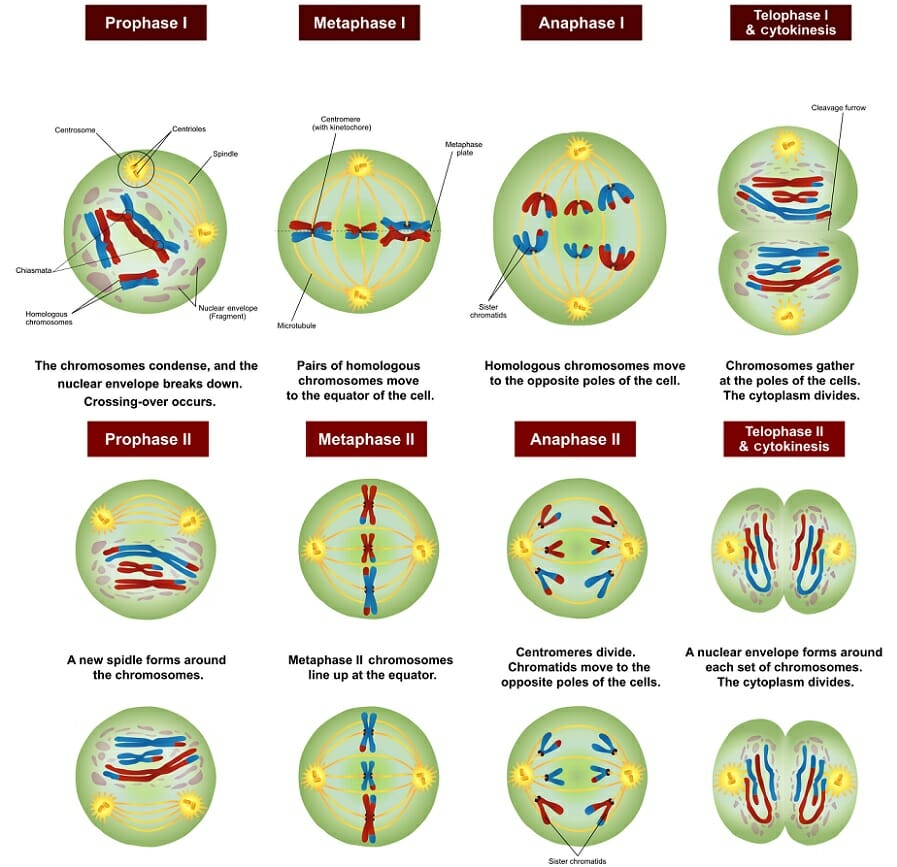What Are the Two Distinct Divisions of Meiosis
Meiosis consists of two divisions meiosis I and meiosis II. Meiosis II Equational division.

Meiosis Definition Stages Function And Purpose Biology Dictionary
Meiosis II Prophase II.
. Segregation of chromosomes is however random. However meiosis includes two nuclear divisions. The main differences between the processes occur in the first division of meiosis in which homologous chromosomes are paired and exchange non-sister chromatid segments.
Mitosis produces 2 diploid cells. However two chromatids of each chromosome. These chromatids are separated in the.
The chromosomes align along the equatorial plate. At the end of meiosis II each daughter cell has 23 chromosomesMeiosis I and meiosis II both have four stages. Where the Sex Starts - Crash Course Biology 13.
Meiosis occurs in two distinct divisions with different phases in each. The first division of meiosis is called heterotypic or reduction division. In humans body or somatic cells are diploid containing two sets of chromosomes one from each parent.
The two distinct divisions of meiosis are meiosis I and meiosis II. The two divisions of meiosis are called meiosis I and II. It is already mentioned that during meiosis the mother nucleus divides twice ie heterotypic division is followed by homotypic division.
The four daughter cells resulting from meiosis are haploid and genetically distinct. Meiotic divisions include two nuclear divisions that produce four daughter nuclei that are genetically different and have one chromosome set instead of the two sets of chromosomes in the parent cell. In each of the nucleus of dyad the chromosomes reappear.
While in Meiosis two germ cells mix together to form four genetically different daughter cells. The two chromatids of a chromosome become genetically different due to crossing over. In meiosis I homologous chromosomes are separated into different nuclei.
Two successive nuclear divisions occur Meiosis I Reduction and Meiosis II Division. Accordingly the processes in meiosis II have the exact same names. During prophase I differences from mitosis begin to appear.
Before a dividing cell enters meiosis it undergoes a period of growth called interphase. Because homologous chromosomes separate in the first division the daughter cells no longer have copies of each chromosome from both parents so they have haploid genetic information and a 1N chromosome number. Chromosome number is cut in half.
The period prior to the synthesis of DNA. However they also differ greatly with meiosis I being reductive division and meiosis II being equational division. Ad Over 27000 video lessons and other resources youre guaranteed to find what you need.
Mitosis produces two identical diploid daughter cells. There are two types of cell division. Meiosis I and meiosis II.
At the end of the meiotic process four daughter cells are produced. This is better illustrated in the diagram below. Meiosis II is the second meiotic division and usually involves equational segregation or.
Unlike mitosis meiosis is a reduction division the chromosome number is halved from diploid 46 chromosomes in 23 pairs in humans to haploid 23. During Mitosis the cell divides into genetically alike daughter cells. Meiosis I and II are similar in some aspects including the number and arrangement of their phases and the production of two cells from a single cell.
Meiosis produces four non-identical haploid gametes sex cells. Meiosis 1 and meiosis 2Meiosis 1. In this way meiosis II is more similar to mitosis.
This is the reduction division. There are two stages or phases of meiosis. The spindle fibres are developed at right angle to the first division and are attached to the.
On the contrary the chromosomes in metaphase I were in. In this manner what are the two cell divisions in meiosis. Prophase metaphase anaphase and telophase.
Meiosis consists of two separate divisions. Meiosis then consists of two cell divisions known as meiosis I and meiosis II. In this phase the cell increases in mass in preparation for cell division.
During this division the number of chromosomes is reduced to half. Before meiosis the DNA is replicated as in mitosis. Meiosis is a type of cell division in sexually reproducing organisms that reduces the number of chromosomes in gametes the sex cells or egg and sperm.
In the first division which consists of different phases the duplicated DNA is separated into daughter cells. The chromosome number is reduced from 2N to 1N in the first meiotic division and stays at 1N in the second meiotic division. There are two types of cell division.
Additionally what happens during the second meiotic division. Meiosis consists of meiosis I and meiosis II. In the next division which.
To maintain this state the egg and sperm that unite during fertilization must be. Centrosomes migrate to either. In this article we will learn about both these processes in detail with their stages and diagrams.
Meiosis and mitosis are both preceded by one round of DNA replication. Members of each homologous pair of chromosomes separateMeiosis 2. The chromatin condenses into chromosomes.
The daughter cells resulting from mitosis are diploid and identical to. The two cromatids of each chromosome separate. The number of chromosomes is reduced to half in the heterotypic division whereas the homotypic division is mitotic one and here number of chromosomes remains same.
As in mitosis the chromosomes begin to condense but in meiosis I they also pair up. Meiosis I is responsible for genetic diversity while meiosis II reduces the amount of DNA in the daughter cells. As in mitosis the cell grows during G phase copies all of its chromosomes during S phase and prepares for division during G phase.
Both stages of meiosis are important for the. Meiosis II is very similar to mitosis. Meiosis produces 4 haploid cells.
Sister chromatids are pulled to.

No comments for "What Are the Two Distinct Divisions of Meiosis"
Post a Comment